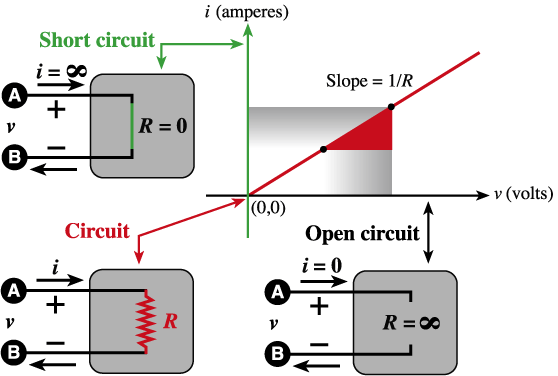The Source
The source is a device, which supplies
electrical energy to a circuit.
- Sources are categorized as being one
of two types:
- voltage sources or current sources.
- The voltage of a voltage source is specified,
but the current is determined by the rest
of the circuit.
- The source may consist of:
- a simple dry cell (as in a flashlight)
- a storage battery (as in an automobile)
- or alternating current (AC) power
supply (such as a socket outlet at
homes and offices).
Reference Point
A reference point is an arbitrarily
chosen point to which all other points in
the circuit are compared (see Figure 7.1).
-
Any point in a circuit may be considered
as a reference and the electrical potential
at all other points may be determined
in reference to that point.
-
The reference point of a circuit is
always considered to be at zero potential.
-
Since the earth (ground) is said to
be at a zero potential, the term ground
is used to denote a common electrical
point of zero potential.
Open Circuit
A circuit element whose resistance approaches
infinity (R = ?) is called an open circuit
and accordingly no current can flow in the
circuit (see Figure 7.2). This may happen
when a break exists in a closed loop. Although
an open circuit occurs when a switch is
used to de-energize a circuit, an open circuit
may also develop accidentally. To restore
a circuit to proper operation, the open
circuit must be located, its cause determined,
and repairs made.
Occasionally an open circuit may be located
visually by a close inspection of the circuit
components. Defective components, such as
burned out resistors, may usually be discovered
by this method. Others, such as a break
in wire covered by insulation or the melted
element of an enclosed fuse, are not visible
to the eye.

| Figure
7.2 |
Three Types of
Circuits and Graphical Representation
of Voltage-Current Relationship |
Short Circuit
Another type of circuit is the short circuit.
This is a circuit that has very little or
no resistance to limit the flow of current.
According the voltage across the circuit
or part of the circuit will approach zero,
regardless of the current flowing through
it. A short circuit generally occurs when
the conductors leading from and back to
the power source become connected (see Figure
7.2).
Grounded Circuit
Another type of circuit is the grounded
circuit which may cause an excessive amount
of current flow just as a short circuit
does. Grounded circuits occur when a path
other than the intended, is established
to ground. Many circuits contain an extra
conductor called the grounding conductor,
which provides the return path and completes
the circuit back to the power source. The
grounding conductor is generally connected
to the case of the appliance to provide
a low resistance path to ground.
|